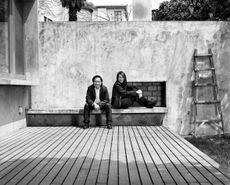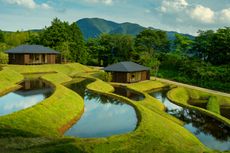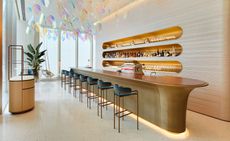Teruhiro Yanagihara creates terroir-inspired interiors for new restaurant Sower in Japan
Sower, the new Japanese restaurant on Lake Biwa, features a minimalist design and a material palette inspired by its surroundings
- (opens in new tab)
- (opens in new tab)
- (opens in new tab)
- Sign up to our newsletter Newsletter
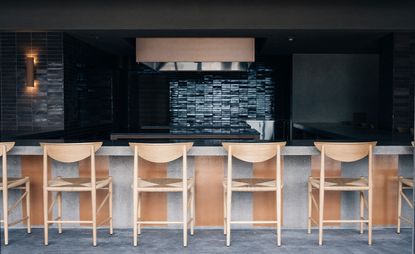
Straw, pearl shells, river stones, clay. A cornucopia of natural materials sourced from the landscape define the interiors of the new Sower restaurant in rural Japan, overlooking the serene waters of Lake Biwa in the mountainous Shiga Prefecture.
The Japanese restaurant was designed by Teruhiro Yanagihara Studio, which carefully applied the concept of ‘terroir’ to the interior, tempering the warm textures of natural materials with clean, minimalist lines and contemporary metal accents. The design smoothly complements the culinary innovations of US chef Coleman Griffin (formerly of Tokyo’s Inua restaurant), who offers a creative, modern take on the region’s rich seasonal produce, and its heritage as the birthplace of Japan’s fermentation culture.

And so the rugged natural Shiga landscape is the main protagonist throughout, from the textures of the plaster walls, the surface of the stone counters and the deep water shades of the ceramic glazes, right down to the contents of the plates.
‘I thought it was very important to design a restaurant that is connected to the landscape around it,’ says Teruhiro Yanagihara, who has studios in Osaka and Arles, France, and serves as creative director and designer at 1616/Arita Japan. ‘Similar to the food served at the restaurant, the space was created using soil, stones and plants from the surrounding Shiga region. We worked closely with craftsmen to create the best use of these materials.’
The restaurant, located in the grounds of Lake Biwa’s L’Hotel du Lac, is accessed via large doors, made from assamela wood, with clean-lined copper handles and ceramic inserts. These lead to a bar area where walls and ceilings have been swathed in textured sakan plaster by artisan Saito Arato, who created an organic fusion of Shigaraki clay, straw and small stones from a local river, while a smooth floor of local soil and cement is awash with dark Bengala mud dye. The bar counter, likewise, contains an organic microcosm of Shiga’s landscape, its smooth terrazzo-style surface showcasing a polished mix of river stones in white cement and natural ceramic clay.

Acclaimed Shiga-based contemporary ceramics studio Nota & Design crafted expanses of vertical tile panels with a light milky white glaze using powdered waste pearl shells from Lake Biwa, set into both the counter sides and plaster walls.
Meanwhile, bar stools showcase curved oak staves expertly handcrafted by Hiroshima-based Sasimonokagu Takahashi, brass footrests, and soft semicircular seats topped with a warm grey textile from Kvadrat’s Yanagihara-designed Haku collection.
The angular space flows around a corner into the main restaurant area, where the earth-inspired palette, natural materials and clean-lined aesthetic continue. Here, another large terrazzo-style counter wraps around an open kitchen, next to a wall of Nota-designed tiles in a deep watery shade called Biwako Blue. Meanwhile, the minimalist tubular lines of unglazed Shigaraki clay, also by Nota, hang on walls, transformed into atmospheric light fixtures by the Nara-based New Light Pottery.
Guests also dine at circular Japanese ash tables with oxidised black legs, accompanied by oak chairs with woven cord seats by Danish brand &Tradition, reflecting the tangible connection Yanagihara sensed between the landscapes of Scandinavia and Lake Biwa.
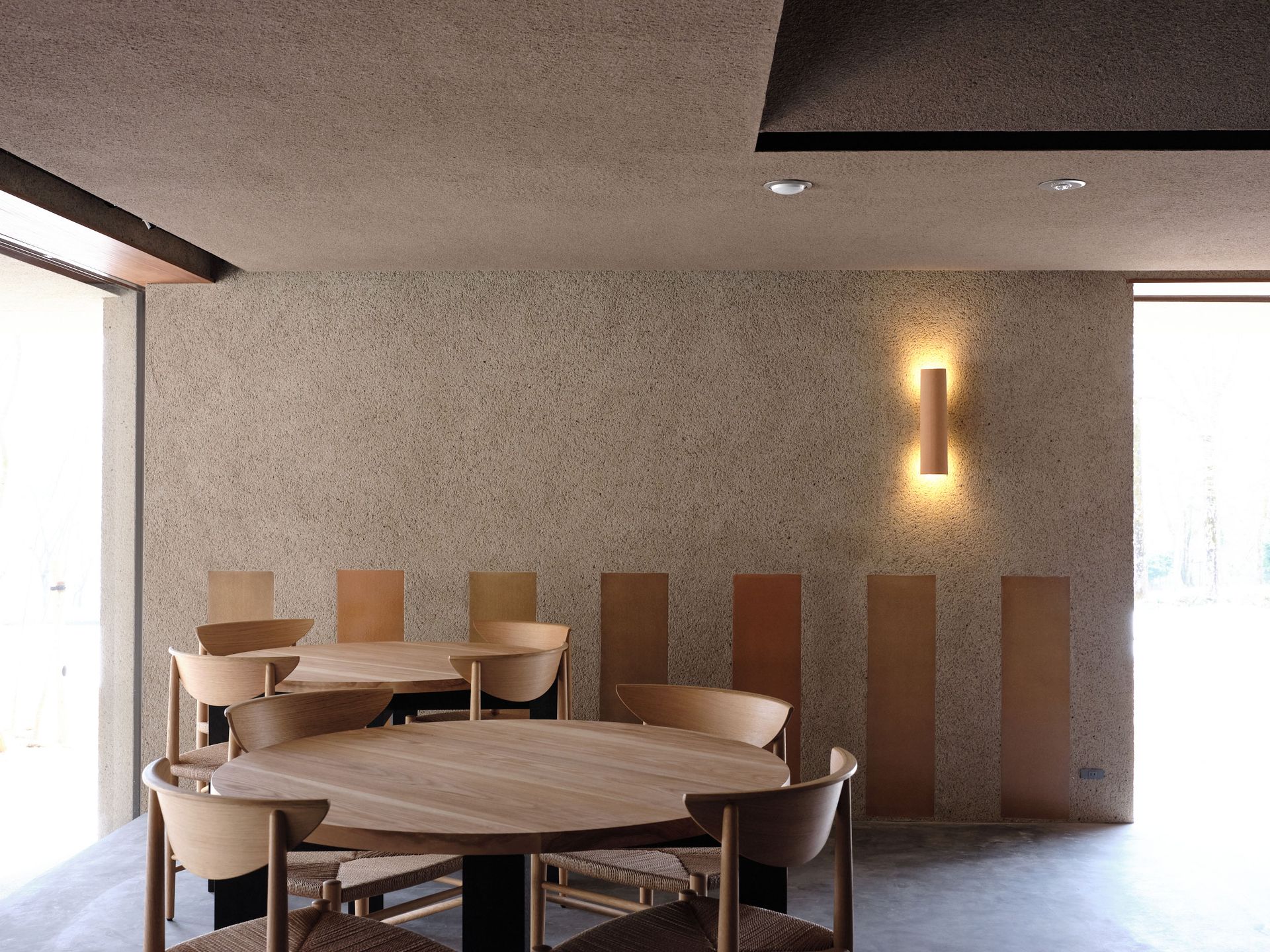
Sharp hints of light-catching copper along parts of the walls temper the natural materials, while in an intimate private dining room, an organic expanse of camphor wood forms a tabletop centrepiece, sitting atop a burnt and polished base of the same wood.
Griffin prepares a bold and imaginative visual feast, with ingredients sourced from the surrounding land and waters. Launch highlights include shrimp and yam donuts; deer, pickled strawberries, and smoked and dried tomatoes; and burnt fig wood ice cream, all served on ceramics by both Nota and 2016/Arita Japan, alongside original knives crafted by Ryusen Hamono.
And just like the nature that surrounds it, the space will continue to evolve. ‘It’s like the architecture of a shrine or a tearoom,’ says Yanagihara. ‘As the earthen walls and the woodwork are exposed to wind and sunlight, their beauty will deepen with time.’

INFORMATION
@restaurant_sower (opens in new tab)
-
 Marre Moerel’s swinging flame candle uses artful balance
Marre Moerel’s swinging flame candle uses artful balanceVita Balanza by Marre Moerel and Santa & Cole has turned candles into a balancing act
By Martha Elliott • Published
-
 At home with Neri & Hu
At home with Neri & HuArchitectural super-pair Neri & Hu talk to us about what inspires them, what they are reading, and how they switch off
By Ellie Stathaki • Published
-
 Year in review: top 10 transport stories of 2022, as selected by Wallpaper’s Jonathan Bell
Year in review: top 10 transport stories of 2022, as selected by Wallpaper’s Jonathan BellTop 10 transport stories of 2022, from minimalist motor cars to next-generation campers: transport editor Jonathan Bell’s picks
By Jonathan Bell • Published
-
 Kyoto's Maana Kiyomizu boutique hotel is the epitome of modern craftsmanship
Kyoto's Maana Kiyomizu boutique hotel is the epitome of modern craftsmanshipMaana Homes’ latest boutique hotel with a twist opens in Kyoto, including suites, a café, and a shop specialising in modern Japanese craftsmanship
By Danielle Demetriou • Last updated
-
 Kai Yufuin by Kengo Kuma revisits Japanese farmhouse architecture
Kai Yufuin by Kengo Kuma revisits Japanese farmhouse architectureHoshino Resorts has launched Kai Yufuin, a hot spring ryokan hotel by Kengo Kuma on the island of Kyushu in the Ōita Prefecture
By Feride Yalav-Heckeroth • Last updated
-
 Kengo Kuma’s Ace Hotel Kyoto opens in a converted telephone office
Kengo Kuma’s Ace Hotel Kyoto opens in a converted telephone officeDiscover the design details of Asia's first Ace Hotel, as realised by architect Kengo Kuma and Commune Design
By Danielle Demetriou • Last updated
-
 K5 — Tokyo, Japan
K5 — Tokyo, JapanBy Danielle Demetriou • Last updated
-
 The Trip: explore the ancient and modern worlds of Nara, Japan
The Trip: explore the ancient and modern worlds of Nara, JapanWeekly at Wallpaper*, ‘The Trip' takes you on a detailed tour of an under-explored town, city or territory, direct from your living room. This week, we journey to the revered Japanese capital, Nara, which has been experiencing a cultural renaissance, led by a savvy herd of young creatives
By Jens Jensen • Last updated
-
 Maja Hotel — Kyoto, Japan
Maja Hotel — Kyoto, JapanBy Danielle Demetriou • Last updated
-
 Sowaka — Kyoto, Japan
Sowaka — Kyoto, JapanBy Daven Wu • Last updated
-
 Louis Vuitton Maison Osaka Midosuji — Osaka, Japan
Louis Vuitton Maison Osaka Midosuji — Osaka, JapanBy Daven Wu • Last updated

